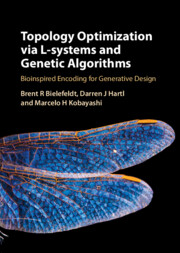 Topology Optimization via L-Systems and Genetic Algorithms
Topology Optimization via L-Systems and Genetic Algorithms Book contents
- Frontmatter
- Contents
- 1 Introduction
- 2 Review of Topology Optimization Methods
- 3 Introduction to L-systems and Turtle Graphics Interpretation
- 4 Spatial Interpretation for the Development of Reconfigurable Structures (SPIDRS)
- 5 Arrangement L-system Interpretation
- 6 Multiphysical Applications
- Appendix A Vector Spaces
- Appendix B Classical Methods in Optimization
- Appendix C Classical Simplex-Based Approach to Ground Structure Optimization
- Appendix D Increasing Structural/Networking Feasibility in Turtle-Constructed Graphs
- Appendix E Conversion of Graphs to Volumetric Bodies for Three-Dimensional Analysis and Additive Manufacturing
- References
- Index
1 - Introduction
Published online by Cambridge University Press: 13 June 2025
- Frontmatter
- Contents
- 1 Introduction
- 2 Review of Topology Optimization Methods
- 3 Introduction to L-systems and Turtle Graphics Interpretation
- 4 Spatial Interpretation for the Development of Reconfigurable Structures (SPIDRS)
- 5 Arrangement L-system Interpretation
- 6 Multiphysical Applications
- Appendix A Vector Spaces
- Appendix B Classical Methods in Optimization
- Appendix C Classical Simplex-Based Approach to Ground Structure Optimization
- Appendix D Increasing Structural/Networking Feasibility in Turtle-Constructed Graphs
- Appendix E Conversion of Graphs to Volumetric Bodies for Three-Dimensional Analysis and Additive Manufacturing
- References
- Index
Summary
Topology optimization is a powerful tool that, when employed at the preliminary stage of the design process, can determine potential structural configurations that best satisfy specified performance objectives. This chapter explores both the different classifications of topology optimization methodologies and their implementation within the design process, specifically highlighting potential areas where such techniques may fall short. This motivates a discussion on the relevance of a bioinspired approach to topology optimization known as EvoDevo, where topologies developed by interpreting instructions from a Lindenmayer system (L-system) encoding are evolved using a genetic algorithm. Such an approach can lend itself well to multiobjective design problems with a vast design space and for which users have little/no experience or intuition.
Keywords
Information
- Type
- Chapter
- Information
- Topology Optimization via L-Systems and Genetic AlgorithmsBioinspired Encoding for Generative Design, pp. 1 - 24Publisher: Cambridge University PressPrint publication year: 2025